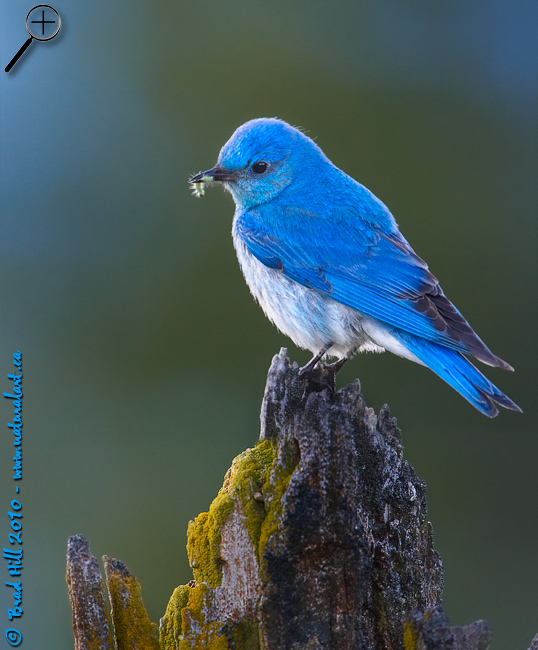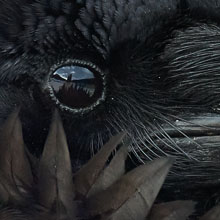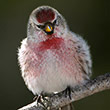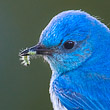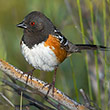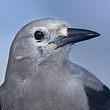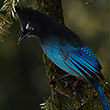Availability: Undetermined - Enquiries?
In the Field
Dawn Bluebird. Findlay Creek, BC, Canada. June 12, 2010.
In recent weeks I've had some fun "pushing" my D3s a little. This image was shot a good half hour BEFORE sunrise. At first glance it may just appear to be a pretty standard shot of a male Mountain Bluebird perched with a small caterpillar in its beak (about to feed complaining nestlings located in a cavity further down the snag). But it's a shot I couldn't have thought of capturing just a few years ago. This image was shot with a "lot of lens" (600mm plus 1.4x teleconverter, for a total of 850mm). In low light. And with two major constraints - I needed a small aperture to get enough depth of field to ensure the whole bird is in focus (and to squeeze maximum quality out of the teleconverter) and I needed a shutter speed fast enough to freeze the quickly moving bird. The solution? Simple - crank the ISO up to 3200. But just two or three years ago this would have produced an image with so much noise that it would be pretty much unusable! So now the clean images possible at high ISO's have allowed me to experiment with the soft, pre-dawn light on a subject that normally required a whole lot more light to effectively capture. In other words, I can approach subjects in a way - or in conditions - never possible before. Exciting? You bet! About the only down side I can see is that these dramatically improved low-light capabilities are really messing up my sleep patterns - this image was shot after my 6th consecutive day of getting up at 4:15! Ouch!
Back in the film era (or even the JPEG era), one normally tried to capture an image in close to final form. When it came to flash-fill (which was used in this image), it meant that one had to get the fill just right in-camera, which was often tricky and also often resulted in images that had the "flash-used-here" look (basically over-filled). Now that I shoot and understand the power of raw image capture and processing, I approach flash-fill completely differently. Now I back WAY off on my fill (often 1-2 full stops) and try to add just enough light to give me sufficient colour and shadow detail to work with during image processing that my adjustments don't add noise to the image (i.e., with the knowledge that I can selectively increase the exposure in key areas of the image). Ultimately I find it way easier to produce visually pleasing results by using this "fill with just enough light to process the image" approach. This is just another example of how truly and fully embracing digital technology can (and should) influence how you capture images in the field!
Behind the Camera
Dawn Bluebird. Findlay Creek, BC, Canada. June 12, 2010.
Digital Capture; RAW 14-bit format; ISO 3200.
Nikon D3s with Nikkor 600mm f4 VR lens paired with 1.4x TC-14EII teleconverter (total focal length of 850mm) - supported on Gitzo 1348 tripod with Wimberley head. VR on and set to "Normal" mode. Nikon SB-900 Speedlight used for flash fill.
1/125s @ f10; -0.33 stop compensation from matrix-metered exposure setting of camera. Flash set a -1.7 stops compensation (on matrix balanced flash fill mode).
At the Computer
Dawn Bluebird. Findlay Creek, BC, Canada. June 12, 2010.
RAW Conversion to 16-bit TIFF, including first-pass/capture sharpening using Phase One's Capture One Pro 5. Three RAW conversions at different exposure settings. Exposure settings varying from -0.8 stops compensation (to retrieve highlight detail on bird's breast) through to +0.5 stops to retrieve shadow detail in the tail region.
Further digital corrections on 16-bit TIFF file using Adobe's Photoshop CS5 and Light Craft's LightZone. Photoshop adjustments included compositing and masking of 3 exposure versions, selective saturation and desaturation of colours and selective sharpening for web output. Final tonemapping and tweaking performed with LightZone use the (tonemapper/re-light tool). No noise reduction performed on iamge (other than that automatically applied by the Capture One Pro raw converter).
Conservation
Dawn Bluebird. Findlay Creek, BC, Canada. June 12, 2010.
Species Status in Canada*: This species is not designated as at risk.
The Mountain Bluebird (Sialia currucoides) is a brilliantly coloured thrush found over much of western North America. Despite its name, it is NOT limited in distribution to mountain regions. In the early 1900's Mountain Bluebird populations plummeted due to loss of nesting habitat (natural cavities) due to the introduction of alien species, including House Sparrows and Starlings. An aggressive conservation effort in the form of the introduction of species-specific nest boxes worked and today bluebirds are common again.
This adult male Mountain Bluebird was photographed in the East Kootenays of BC, Canada. The area supports a strong population of Mountain Bluebirds and smaller population of Western Bluebirds.
One of the most fascinating things about the Mountain Bluebird is that the striking ultraviolet-blue coloration of feathers does not come from any type of pigment that has been incorporated into feathers. Instead, the source of the coloration is completely "structural" in that the microanatomy of the feather barbs in a way that primarily reflects ultraviolet and blue light while largely absorbing wavelengths of light that are perceived by humans as other colors (green, yellow, red, etc.). So what you are seeing is differentially reflected ultraviolet-blue light...NOT pigmentation!
*as determined by COSEWIC: The Committee on the Status of Endangered Wildlife in Canada













